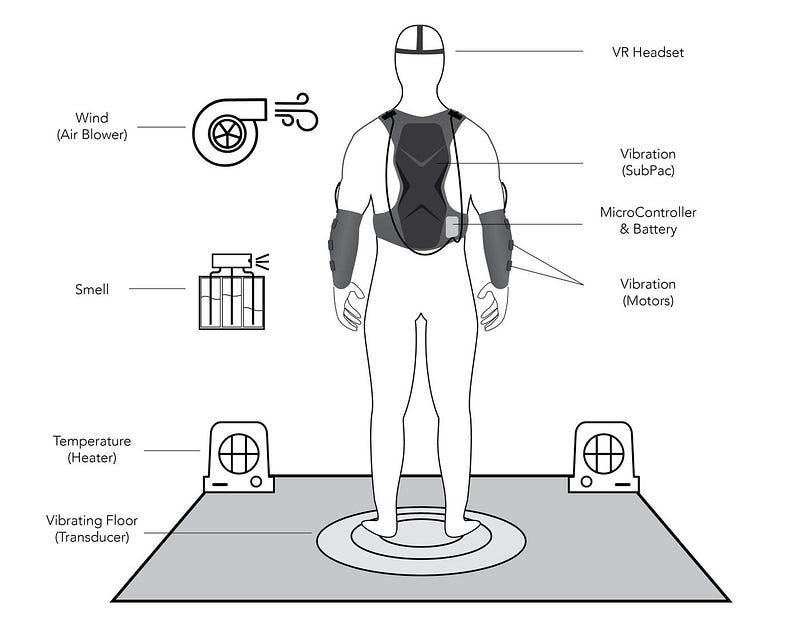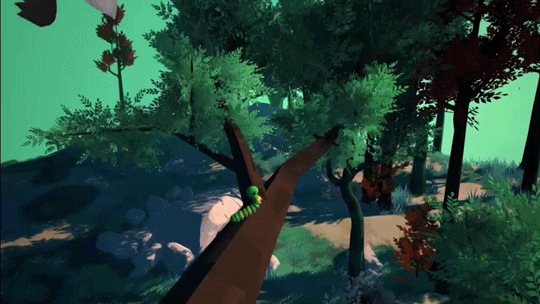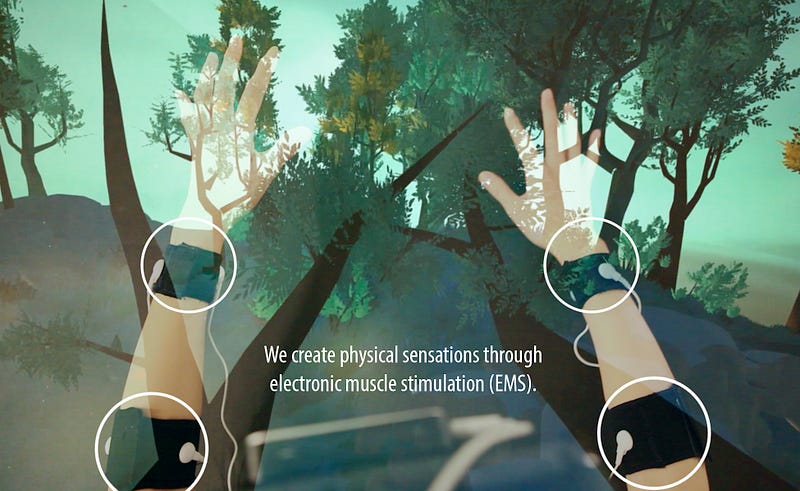If you were a tree
Virtual reality opens up a novel perspective in storytelling and engagement. It’s what seeded our VR film projects TreeSense and Tree.
By Xin Liu and Yedan Qian
In
June of last year, we started a research project on understanding and
developing body ownership illusion in virtual reality (VR). A couple of
months later, our research grew into a VR narrative film we called TreeSense.
Then, in October, we started collaborating with movie directors to push
the project further and to develop a hyper-realistic VR film, called Tree.
All
this work is based on our belief that virtual reality (VR) offers new
ways of storytelling and engagement. Through systematic alteration of
the human body’s sensory stimuli, such as vision, touch, motor control,
and proprioception, our brains can be trained to inhabit different
entities. Virtually experiencing a different state of being can lead to a heightening of empathy, of appreciation for others’ realities.
To
showcase the power of this embodied storytelling method, we decided to
create a sensory-enhanced VR film in which a person inhabits a
tree — indeed becomes a
tree — seeing and feeling their arms as branches and their body as the
trunk. The audience members collectively share the experience of being a
tree throughout its life cycle — from a seed rising through the dirt,
to sprouting branches and growing to full size, until finally the tree
is destroyed by fire. We called this project TreeSense.
TreeSense cultivates Tree
While we were developing TreeSense,
we met VR film directors Milica Zec and Winslow Porter when they spoke
to our class at the Media Lab. At the time, and by an odd coincidence,
they were also developing a similar story about “being” a tree. It was a
very exciting bit of serendipity, and we decided to work together in
order to transform our ideas into the comprehensive VR film experience, Tree. In the Fluid Interfaces group, we took charge of the design and construction of the tactile experiences that are represented throughout Tree, while artist Jakob Steensen designed its stunning hyper-realistic visuals.
In both short films, TreeSense and Tree,
each viewer wears a VR headset and becomes immersed in a virtual
forest. But these projects differ in their tactile technologies. In TreeSense,
we rely on electronic muscle stimulation (EMS) to provide visuotactile
feedback. We’ve designed a series of EMS signals by varying combinations
of pulse amplitude, pulse width, current frequency, and the electrodes’
location. The exciting part of EMS is that we’re able to explore
uncommon body sensations, including feeling electricity underneath the
skin, or fingers moving involuntarily. Audience members can actually
sense their branches growing or getting poked by a bird. This
implementation of EMS is definitely experimental.
In Tree,
we follow a more conventional and mature approach because the project
has to work reliably for hundreds of people when it’s demonstrated in
public events such as film festivals in theaters. Mostly we use
commercial products, such as a Subpac for body vibration. We’ve also
customized localized vibration points on the arm, and used subwoofers in
constructing a floor that vibrates so users can actually feel the
rumblings of a thunderstorm. Whenever there’s thunder, lightning, or
fire in the VR, people also experience how those phenomena “touch” the
tree. We’ve also made use of an air mover to simulate the wind, and
added real-life heating in the space to simulate the fire that threatens
the “tree person.”

We see the film, Tree, as a polished extension of our project, TreeSense.
The VR movie was shown outside the academic environment and seen by
hundreds of audiences in 2017 festivals, including Sundance, TribeCa,
and TED: The Future You. At the Tribeca film festival, the immersive VR
experience of Tree also included the use of scents. The audience literally smelled the dirt, the rain forest, and the fire.
So
far, the presentations at film festivals and elsewhere have been very
well-received. We’ve seen audiences coming out of the VR film experience
in tears. It’s been exhilarating for us to witness the power of body
sensations in this new form of storytelling. People have told us they
really felt like the tree and found its destruction to be terrifying and
emotional. Meanwhile, TreeSense has just received an interaction prize in this year’s Core77 Design Awards and it will be shown at Design Dubai Week in the fall.

Challenges and expectations
Both our projects — Tree and TreeSense — experiment
with new methodologies for immersive participatory storytelling by
leveraging new technologies such as VR and tactile feedback mechanisms.
We’re aiming to evoke believable bodily experiences through electronic
muscle stimulation, vibration, temperature, and scents to unlock a
higher level of realism. As an audience member said after feeling
immersed in Tree, “You know it’s not real but your body really believes it!”
The
design of multi-sensory experiences is a complicated process of
composition and choreography. We constantly have to make sure the
experiences are perfectly synced, both in terms of timing and intensity.
There’s already high-fidelity visual and audio inside the VR headset,
but it’s not a trivial thing to add tactile elements to enhance the experience, and not distract or disturb the user.
In Tree,
we have multitrack bass audios for each part of the body vibration, so
that a person can feel the thunder, or the forest fire disturbance, or a
bird landing on a branch. The whole tactile experience is digitally
controlled by Max/MSP and Arduino software while communicating with the
Unreal engine through Open Sound Control protocol. The tactile,
olfactory, and temperature feedback in real life is precisely synced
with the visual experience inside the Oculus headset. We went through
various iterations to match the virtual visual details with the
intensity, texture, and timing of the physical experiences.

We believe that TreeSense and Tree
are tapping into more senses to help people connect with the narrative.
We expect that the intimate, visceral, and emotional VR experience also
has a real-world impact in that it helps users to develop a personal
and immediate identification with the natural environment and the need
to protect it.
In that sense, Tree
is an example of a multisensory VR platform that has vast potential
outside the research world. We’re convinced of the technology’s
potential value for diverse purposes in many areas, such as
telecommunication, active learning, and even medical applications. We
are actively exploring these possibilities now.
Xin Liu is a research assistant in the Fluid Interfaces group at the MIT Media Lab. She graduates with a master’s degree in August. Yedan Qian is a visiting student in Fluid Interfaces.
Acknowledgments:
- Advisor: Pattie Maes, head of the Fluid Interfaces research group at the MIT Media Lab.
- Collaborators: VR filmmakers Milica Zec and Winslow Porter.
This post was originally published on the Media Lab website.
Comments
Post a Comment